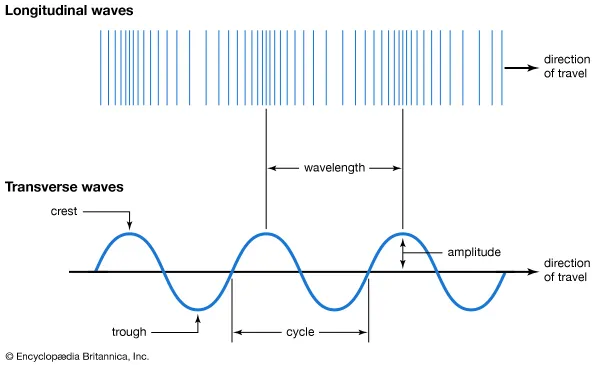
Physics - Transverse vs Longitudinal Waves
Intro to Waves
a wave is defined as - the transfer of energy without the transfer of matter, also known as wave motion
there are 2 types of waves that can transfer energy:
transverse - particle vibrate at right angles to the direction of the wave, for example ocean waves
longitudinal - particles vibrate in the same direction as the wave motion, but backwards and forwards, for example sound waves

the number of waves produced a second is called the frequency
there is no net change in transverse waves, and the wave travels away from its source
period - time for one wave to pass through a fixed point
wavelength - how long a wave is, measure peak to peak or trough to trough
amplitude - the heights of the wave, and the displacement from the rest position
frequency is measured in Hertz (Hz)
1 wave passing a point = 1 Hz
The Seven Qualities of a Transverse Wave
wavelength (lambda)
frequency (Hz)
crest
trough - max downward value
amplitude - max upward value
period
wave speed
Everything is made up of atoms - even air has atoms
when one atoms bumps another, energy is transferred mechanically
mechanical energy transfer - one atom bumps another
vibration - a rapid continuous movement, creates sound waves
longitudinal waves are sometimes called pressure waves
longitudinal waves move to and fro in the direction of the energy flow
Calculating Wave Velocity
period - time needed to complete a wavelength
speed, frequency, and wavelength are linked by the wave equation
if frequency increases, wavelength decreases, and vice versa
wave equation - v = f λ
v = speed of wave (m/s)
f = frequency of wave (Hz)
λ = wavelength of wave (m)
to calculate frequency - f = v/λ
to calculate wavelength - λ = v/f
Physics - Transverse vs Longitudinal Waves
Intro to Waves
a wave is defined as - the transfer of energy without the transfer of matter, also known as wave motion
there are 2 types of waves that can transfer energy:
transverse - particle vibrate at right angles to the direction of the wave, for example ocean waves
longitudinal - particles vibrate in the same direction as the wave motion, but backwards and forwards, for example sound waves

the number of waves produced a second is called the frequency
there is no net change in transverse waves, and the wave travels away from its source
period - time for one wave to pass through a fixed point
wavelength - how long a wave is, measure peak to peak or trough to trough
amplitude - the heights of the wave, and the displacement from the rest position
frequency is measured in Hertz (Hz)
1 wave passing a point = 1 Hz
The Seven Qualities of a Transverse Wave
wavelength (lambda)
frequency (Hz)
crest
trough - max downward value
amplitude - max upward value
period
wave speed
Everything is made up of atoms - even air has atoms
when one atoms bumps another, energy is transferred mechanically
mechanical energy transfer - one atom bumps another
vibration - a rapid continuous movement, creates sound waves
longitudinal waves are sometimes called pressure waves
longitudinal waves move to and fro in the direction of the energy flow
Calculating Wave Velocity
period - time needed to complete a wavelength
speed, frequency, and wavelength are linked by the wave equation
if frequency increases, wavelength decreases, and vice versa
wave equation - v = f λ
v = speed of wave (m/s)
f = frequency of wave (Hz)
λ = wavelength of wave (m)
to calculate frequency - f = v/λ
to calculate wavelength - λ = v/f
 Knowt
Knowt
